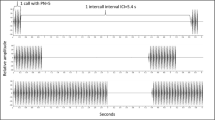Abstract
The role of acoustic cues as reference cues for orientation by amphibians has been demonstrated in anurans, the only amphibian group that engages in acoustic communication, but not in urodeles. Orientation responses of marbled newts, Triturus marmoratus, were studied to determine whether heterospecific calls elicited positive phonotaxis. The orientation tests consisted in presenting either a familiar acoustic stimulus, the advertisement calls of natterjack toads (Bufo calamita), or a control stimulus, the advertisement calls of European green toads (Bufo viridis) that the newts would not be expected to recognize. Marbled newts and natterjack toads occur in simpatry, but T. marmoratus and B. viridis are allopatric species. Thus, T. marmoratus is distributed over the northern half of the Iberian Peninsula, whereas B. viridis occurs in the Balearic Islands, but not over the Iberian Peninsula. Newts were released in a circular arena while a recorded chorus of natterjack toads or European green toads played outside the arena to determine whether they displayed positive phonotactic orientation. Our results show that marbled newts performed positive phonotaxis when exposed to the breeding calls of natterjack toads, but not to those of European green toads. Newts chose a compass course in the direction of the advertisement calls of B. calamita. Acoustic information might improve orientation accuracy. This study is the first to provide evidence of heterospecific call recognition and positive phonotactic response in urodeles.



Similar content being viewed by others
References
Able KP (1980) Mechanisms of orientation, navigation, and homing. In: Gauthreaux SA Jr (ed) Animal migration, orientation and navigation. Academic Press, New York, pp 283–373
Able KP (1991) Common themes and variations in animal orientation systems. Am Zool 31:157–167
Adler K (1980) Individuality in the use of orientation cues by green frogs. Anim Behav 28:413–425
Batschelet E (1981) Circular statistics in biology. Academic Press, London
Bosch J, Rand AS, Ryan MJ (2000) Signal variation and call preferences for whine frequency in the tungara frog, Physalaemus pustulosus. Behav Ecol Sociobiol 49:62–66
Bosch J, Márquez R, Boyero L (2003) Behavioural patterns, preference, and motivation of female midwife toads during phonotaxis tests. J Ethol 21:61–66
Castellano S, Giacoma C (1998) Stabilizing and directional female choice for male calls in the European green toad. Anim Behav 56:275–287
Diego-Rasilla FJ, Luengo RM (2002) Celestial orientation in the marbled newt (Triturus marmoratus). J Ethol 20:137–141
Dole JW (1965) Summer movements of adult leopard frogs, Rana pipiens, in Northern Michigan. Ecology 46:236–255
Ferguson DE, Landreth HF (1966) Celestial orientation of the fowler’s toad Bufo fowleri. Behaviour 26:105–123
Fischer JH, Freake MJ, Borland SC, Phillips JB (2001) Evidence for the use of magnetic map information by an amphibian. Anim Behav 62:1–10
Fisher NI (1995) Statistical analysis of circular data. Cambridge University Press, Cambridge
Gerhardt HC (1988) Acoustic properties used in call recognition by frogs and toads. In: Fritzsch B, Ryan MJ, Wilczynski W, Hetherington T, Walkowiak W (eds) The evolution of the amphibian auditory system. Wiley, New York, pp 253–273
Gerhardt HC (1994) The evolution of vocalizations in frogs and toads. Annu Rev Ecol Syst 25:293–324
Grubb JC (1973) Olfactory orientation in Bufo woodhousei fowleri, Pseudacris clarki and Pseudacris streckeri. Anim Behav 21:726–732
Hetherington T (2001) Laser vibrometric studies of sound-induced motion of the body walls and lungs of salamanders and lizards: implications for lung-based hearing. J Comp Physiol A 187:499–507
Hetherington TE, Lindquist ED (1999) Lung-based hearing in an “earless” anuran amphibian. J Comp Physiol A 184:395–401
Joly P, Miaud C (1989) Fidelity to the breeding site in the alpine newt Triturus alpestris. Behav Process 19:47–56
Joly P, Miaud C (1993) How does a newt find its pond? The role of chemical cues in migrating newts (Triturus alpestris). Ethol Ecol Evol 5:447–455
Kime NM, Turner WR, Ryan MJ (2000) The transmission of advertisement calls in Central American frogs. Behav Ecol 11:71–83
Landreth HF, Ferguson DE (1967) Newts: sun-compass orientation. Science 158:1459–1461
Lindquist ED, Hetherington TE, Volman SF (1998) Biomechanical and neurophysiological studies on audition in eared and earless harlequin frogs (Atelopus). J Comp Physiol A 183:265–271
Márquez R, Mateu E (1995) Sounds of frogs and toads of Spain and Portugal. ALOSA, sonidos de la naturaleza, Barcelona
Pfennig KS, Rapa K, McNatt R (2000) Evolution of male mating behavior: male spadefoot toads preferentially associate with conspecific males. Behav Ecol Sociobiol 48:69–74
Phillips JB (1986) Magnetic compass orientation in the Eastern red-spotted newt (Notophthalmus viridescens). J Comp Physiol A 158:103–109
Schwartz JJ, Buchanan BW, Gerhardt HC (2001) Female mate choice in the gray treefrog (Hyla versicolor) in three experimental environments. Behav Ecol Sociobiol 49:443–455
Sinsch U (1990) The orientation behaviour of three toad species (genus Bufo) displaced from the breeding site. In: Hanke W (ed) Fortschritte der Zoologie, vol 38. Biology and physiology of amphibians. Fischer, Stuttgart
Sinsch U (1992a) Amphibians. In: Papi F (ed) Animal homing. Chapman and Hall, New York, pp 213–233
Sinsch U (1992b) Sex-biased site fidelity and orientation behaviour in reproductive natterjack toads (Bufo calamita). Ethol Ecol Evol 4:15–32
Sun L, Wilzcynski W, Rand AS, Ryan MJ (2000) Trade-off in short- and long-distance communication in túngara (Physalaemus pustulosus) and cricket (Acris crepitans) frogs. Behav Ecol 11:102–109
Wilczynski W, Ryan MJ (1988) The amphibian auditory system as a model for neurobiology, behavior, and evolution. In: Fritzsch B, Ryan MJ, Wilczynski W, Hetherington T, Walkowiak W (eds) The evolution of the amphibian auditory system. Wiley, New York, pp 3–12
Acknowledgements
We are indebted to V. Pérez-Mellado for discussion and for assistance during this study. We sincerely thank M. Diego-Gutiérrez for invaluable technical assistance during this study. Thanks are also due to three anonymous reviewers for invaluable comments and suggestions regarding the manuscript. The experiments reported herein comply with the current laws of Spain.
Author information
Authors and Affiliations
Corresponding author
Additional information
Communicated by W. Wiltschko
Rights and permissions
About this article
Cite this article
Diego-Rasilla, F.J., Luengo, R.M. Heterospecific call recognition and phonotaxis in the orientation behavior of the marbled newt, Triturus marmoratus . Behav Ecol Sociobiol 55, 556–560 (2004). https://doi.org/10.1007/s00265-003-0740-y
Received:
Revised:
Accepted:
Published:
Issue Date:
DOI: https://doi.org/10.1007/s00265-003-0740-y




